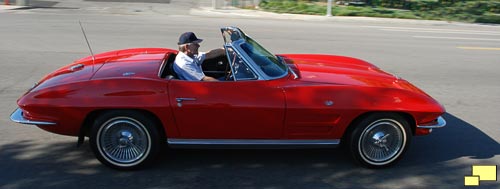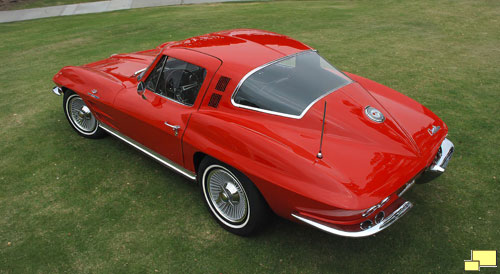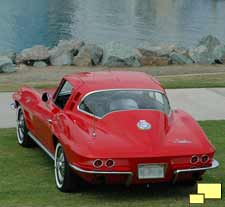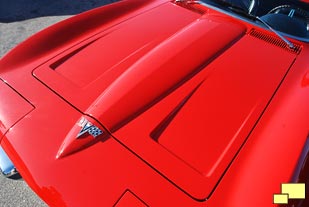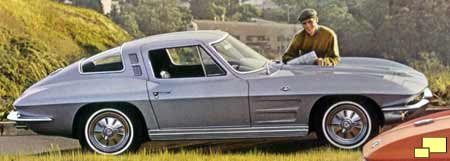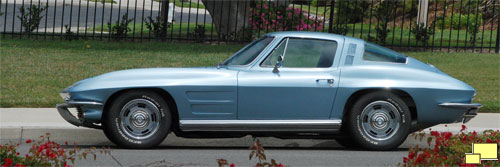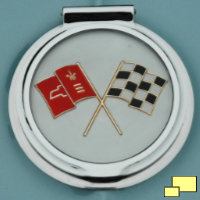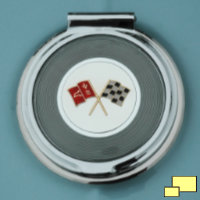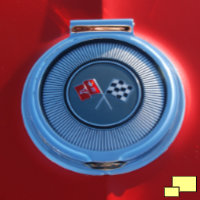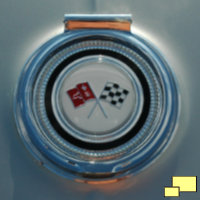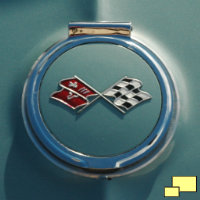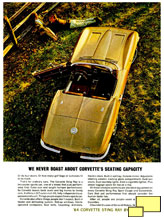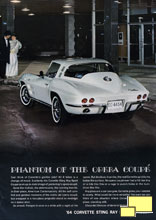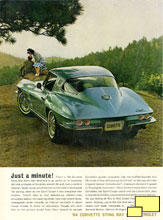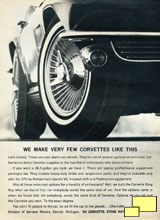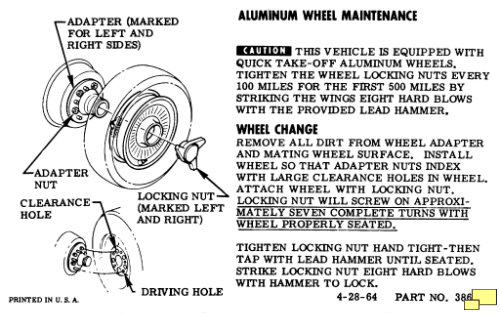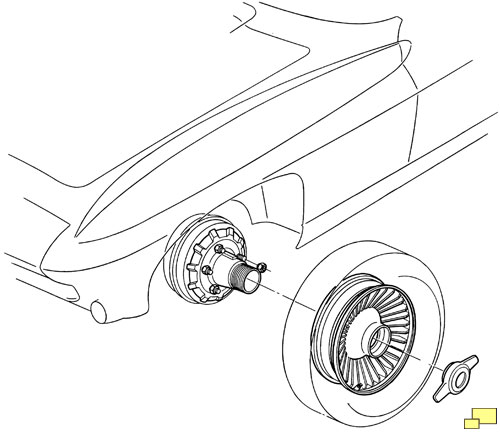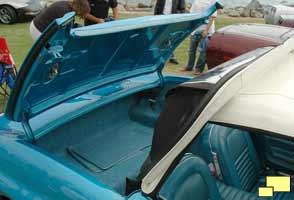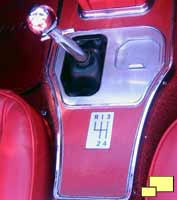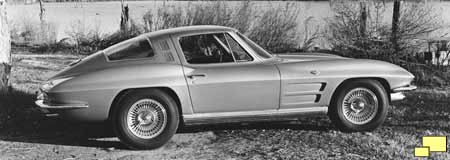Corvette Generations:
C1 C2 C3 C4 C5 C6 C7 C8
Corvette: Year by Year
1953 1954 1955 1956 1957 1958 1959 1960 1961 1962 19631964 1965 1966 1967 1968 1969 1970 1971 1972 1973 1974
1975 1976 1977 1978 1979 1980 1981 1982 1983 1984 1985
1986 1987 1988 1989 1990 1991 1992 1993 1994 1995 1996
1997 1998 1999 2000 2001 2002 2003 2004 2005 2006 2007
2008 2009 2010 2011 2012 2013 2014 2015 2016 2017 2018
2019 2020 2021 2022 2023 2024 2025
1964 Corvette C2 Sting Ray
 People were still catching their breath after the amazing changes in the 1963 Corvette Stingray, so updates for 1964 were minimal. The biggest development was the elimination of the split rear window.
People were still catching their breath after the amazing changes in the 1963 Corvette Stingray, so updates for 1964 were minimal. The biggest development was the elimination of the split rear window.
Another change was the added functionality of the air outlet to the right of the driver's door on the coupe. For 1963 they were closed off, represented by a small indentation. A small fan was added to boost airflow but it was only minimally effective and the whole idea was dropped by 1966. Updated body mounting methods and other changes improved interior noise. The overall build quality, long a legitimate Corvette complaint, was improved.
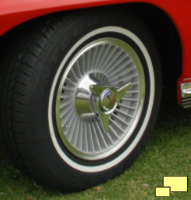 Optional P48 Optional Cast Aluminum Wheels (RPO P48; $322.80) were first widely available in 1964 Corvettes. 806 or 3.63% of the total 1964 production were sold. While you may see the same Cast Aluminum Wheels on '63 Corvettes - they are a popular upgrade - they were not original to the cars as none were sold in 1963.
Optional P48 Optional Cast Aluminum Wheels (RPO P48; $322.80) were first widely available in 1964 Corvettes. 806 or 3.63% of the total 1964 production were sold. While you may see the same Cast Aluminum Wheels on '63 Corvettes - they are a popular upgrade - they were not original to the cars as none were sold in 1963.
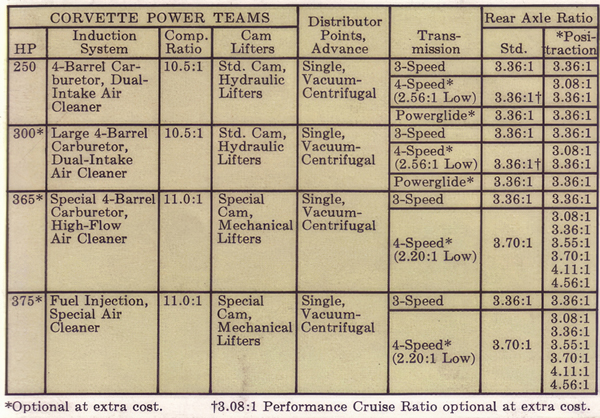
A replacement for the conventional points / condenser system arrived in the form of a transistorized ignition system available as RPO K66.
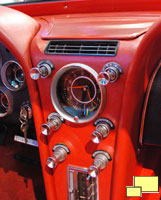
It's easy to determine if a C2 Corvette has Air Conditioning by the vent above the clock. RPO C60 $421.60; 1,988 (8.94%) for the 1964 model year.
1964 Corvette Options, Prices
| RPO | Description | Production | Price |
| Genuine Leather Seats | 1,334 (6.00%) | $80.70 | |
| A01 | Soft Ray Tiknted Glass, all windows | 6,031 (27.13%) | $16.15 |
| A02 | Soft Ray Tinted Glass, windshield | 6,387 (28.73%) | $10.80 |
| A31 | Power Windows | 3,706 (16.67%) | $59.20 |
| C07 | Auxiliary Hardtop (for convertible) | 7,023 (31.59%) | $236.75 |
| C48 | Heater and Defroster Deletion (credit) | 60 (0.27%) | n/a |
| C60 | Air Conditioning | 1,988 (8.94%) | $421.80 |
| F40 | Special Front and Rear Suspension | 82 (0.37%) | $37.70 |
| G81 | Positraction Rear Axle, all ratios | 18,279 (82.23%) | $43.05 |
| G91 | Special Highway Axle, 3.08:1 ratio | 2,310 (10.39%) | $2.20 |
| J50 | Power Brakes | 2,270 (10.21%) | $43.05 |
| J56* | Special Sintered Metallic Brake Package | 29 (0.13%) | $629.50 |
| J65 | Sintered Metallic Brakes, power | 4,780 (21.50%) | $53.80 |
| K66 | Transistor Ignition System | 552 (2.48%) | $75.35 |
| L75 | 327 cu. in. 300hp Engine | 4,780 (21.50%) | $53.80 |
| L76 | 327 cu. in. 365hp Engine | 7,171 (32.26%) | $107.60 |
| L84 | 327 cu. in. 375hp Engine (fuel injection) | 1,325 (5.96%) | $538.00 |
| M20 | 4-Speed Manual Transmission | 19,034 (85.63%) | $188.30 |
| M35 | Powerglide Automatic Transmission | 2,480 (11.16%) | $199.10 |
| N03 | 36 Gallon Fuel Tank (Coupe only) | 38 (0.17%) | $202.30 |
| N11 | Off Road Exhaust System | 1,953 (8.79%) | $37.70 |
| N40 | Power Steering | 3,126 (14.06%) | $75.35 |
| P48 | Cast Aluminum Knock-Off Wheels (5) | 806 (3.63%) | $322.80 |
| P91 | Blackwall Tires, 6.70x15 (nylon cord) | 372 (1.67%) | $15.07 |
| P92 | Whitewall Tires, 6.70x15 (rayon cord) | 19,977 (89.87%) | $31.85 |
| T86 | Back-up Lamps | 11,085 (49.87%) | $10.80 |
| U69 | AM-FM Radio | 20,934 (94.17%) | $176.50 |
|
Total Production:
22,229
Notes: Base Corvette Coupe with 327 cu. in. 250 hp engine and three speed manual transmission: $4,252.00. |
|||
Colors
| Code | Exterior | Quantity | Interior | Soft Top | Wheels |
| 900 | Tuxedo Black | 1,897 (8.53%) | Black / Red / Silver / White | Black / White / Beige | Black |
| 912 | Silver Blue | 3,121 (14.04%) | Black / Blue / White | Black / White / Beige | Black |
| 916 | Daytona Blue | 3,454 (15.54%) | Blue / Silver / White | Black / White / Beige | Black |
| 923 | Riverside Red | 5,274 (23.73%) | Black / Red / White | Black / White / Beige | Black |
| 932 | Saddle Tan | 1,765 (7.94%) | Saddle / White | Black / White / Beige | Black |
| 936 | Ermine White | 3,909 (17.59%) | Black / Blue / Red / Saddle / Silver / White | Black / White / Beige | Black |
| 940 | Satin Silver | 2,785 (12.53%) | Black / Blue / Red / Silver / White | Black / White / Beige | Black |




